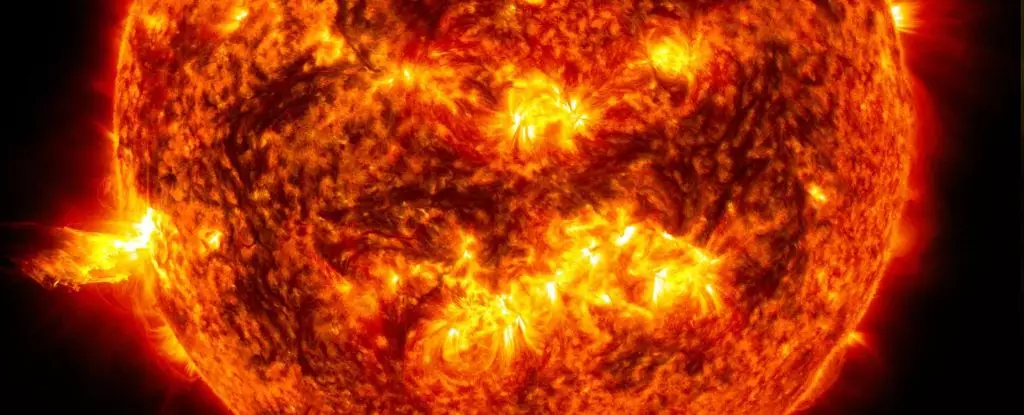For centuries, humanity has looked at the Sun as a bastion of constancy, a fiery celestial furnace unwavering in its rhythm. Yet, recent developments challenge this naive perception, revealing that our star is far more unpredictable and dynamic than previously thought. The expectations set forth at the close of Solar Cycle 24 painted a picture of calm—a gentle lull before the anticipated storm. However, as 2023 unfolds, it becomes painfully clear that the Sun is staging a political coup against our assumptions, ascending into an unexpectedly vigorous phase.
This pivot in solar activity defies long-held scientific predictions. The consensus was that Solar Cycle 25 would mirror its predecessor in mildness, based on models that have historically served as reliable, albeit imperfect, tools for forecasting solar behavior. Instead, the Sun has entered a phase of intensified activity, with an elevation in sunspots, solar flares, and coronal mass ejections that resemble an older, more chaotic solar epoch. This unexpected “resurgence” prompts us to question our models, our understanding, and most critically, our preparedness.
The Hidden Complexity of Solar Dynamics: Beyond 11-Year Cycles
The traditional view of solar activity rests heavily on the 11-year cycle, a seemingly predictable rhythmic dance of sunspots and magnetic reversals. Yet, beneath this rhythmic surface lies an intricate web of processes—some still shrouded in mystery. Historical events like the Maunder Minimum and Dalton Minimum exemplify how solar activity can drastically dip, sometimes showing near silence for decades, without a clear scientific roadmap to predict such phases.
This underscores a critical point: relying solely on sunspot counts and short-term patterns oversimplifies what is undeniably a tempest of internal solar forces. The Sun operates within a longer, more complex framework called the Hale cycle, spanning approximately 22 years. During this period, magnetic poles switch and re-switch, creating a layered cycle that can influence solar behavior far beyond the familiar 11-year rhythm. It’s a reminder that what we see on the surface may just be the tip of a much larger, more chaotic iceberg.
Unanticipated Growth: The Sun Awakens Since 2008
The crux of recent findings rests on long-term data analyses that challenge our perceptions of solar quietude. Starting around 2008, even as solar activity appeared subdued, the solar wind changed its tone — it grew stronger, more energetic, and more persistent. The magnitude of this wind, measured by multiple variables like speed, density, temperature, and magnetic field strength, has been progressively rising.
This slow yet persistent escalation suggests we might be entering a period of intensified solar turbulence—a renaissance of sorts for our star. If this solar ‘rejuvenation’ continues, we could see more powerful storms, energetic flares, and disruptive space weather phenomena. For Earth, this carries tangible risks: potential interference with satellite communications, power grids, and navigation systems, turning the Sun’s caprice into tangible problems for our modern civilization.
The Broader Implications: Rethinking Solar Predictability
The implications extend far beyond immediate space weather concerns. By observing the Sun’s evolving behavior, scientists acknowledge that our traditional indicators—mainly sunspot numbers—are insufficient for grasping the full picture. The comprehensive complexity of solar dynamics demands a paradigm shift, urging us toward broader, more nuanced measures and models.
This newfound perspective beckons a broader question: are we truly capable of predicting solar activity with the precision required for modern technology-dependent societies? The answer, as recent evidence suggests, is a cautious ‘no.’ Our understanding remains partial and fragmented. Instead of relying on seemingly predictable solar cycles, we must embrace a more holistic approach, considering underlying magnetic patterns, long-term cycles, and even the subtle variations that unfold over centuries.
The Spectacle of the Solar Future: A Game of Uncertainty and Opportunity
The Sun’s apparent “waking up” is both a testament to nature’s unpredictability and a call to deepen our understanding. It’s a reminder that even the most familiar cosmic neighbors can surprise us, forcing us to rethink our assumptions. As solar activity shifts into an apparently more turbulent phase, humanity faces not just the prospect of disruptive space weather but also the challenge—and opportunity—to refine our scientific tools, monitor more holistically, and prepare for a future where the Sun’s temperament is as dynamic as its fiery surface.
This period of solar uncertainty might well herald a new chapter in heliophysics—one where we learn to read the subtle signals of our star’s internal heartbeat more accurately, embracing uncertainty as a catalyst for scientific evolution. The Sun’s renaissance serves as both a warning and an inspiration: nature’s most powerful forces ooze unpredictability, and acknowledging that is the first step toward truly understanding and coexisting with the cosmic giant that sustains us.


Leave a Reply